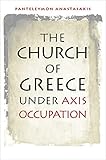The Church of Greece under Axis Occupation / Panteleymon Anastasakis.
Material type: TextSeries: World War II: The Global, Human, and Ethical DimensionPublisher: New York, NY : Fordham University Press, [2014]Copyright date: ©2014Description: 1 online resource (366 p.)Content type:
TextSeries: World War II: The Global, Human, and Ethical DimensionPublisher: New York, NY : Fordham University Press, [2014]Copyright date: ©2014Description: 1 online resource (366 p.)Content type: - 9780823261994
- 9780823262021
- 281.9/49509044 23
- online - DeGruyter
| Item type | Current library | Call number | URL | Status | Notes | Barcode | |
|---|---|---|---|---|---|---|---|
 eBook
eBook
|
Biblioteca "Angelicum" Pont. Univ. S.Tommaso d'Aquino Nuvola online | online - DeGruyter (Browse shelf(Opens below)) | Online access | Not for loan (Accesso limitato) | Accesso per gli utenti autorizzati / Access for authorized users | (dgr)9780823262021 |
Browsing Biblioteca "Angelicum" Pont. Univ. S.Tommaso d'Aquino shelves, Shelving location: Nuvola online Close shelf browser (Hides shelf browser)

|

|

|

|

|

|

|
||
| online - DeGruyter Reading Descartes Otherwise : Blind, Mad, Dreamy, and Bad / | online - DeGruyter Affliction : Health, Disease, Poverty / | online - DeGruyter From a Nickel to a Token : The Journey from Board of Transportation to MTA / | online - DeGruyter The Church of Greece under Axis Occupation / | online - DeGruyter Giorgio Agamben : Beyond the Threshold of Deconstruction / | online - DeGruyter The Trace of God : Derrida and Religion / | online - DeGruyter Sometimes Always True : Undogmatic Pluralism in Politics, Metaphysics, and Epistemology / |
Frontmatter -- Contents -- A Note on Transliterations and List of Abbreviations -- Acknowledgments -- Introduction -- 1 Historical Background -- 2 The Making of an Ethnarch -- 3 A Prelude of Events to Come -- 4 Unattainably High -- 5 The Fruits of Their Labor -- 6 Combating Famine and Destitution (1941– 1944) -- 7 The Path of Passive Resistance and Protest -- 8 In the Spirit of Papaflessas -- Epilogue -- Notes -- Bibliography -- Index
restricted access online access with authorization star
http://purl.org/coar/access_right/c_16ec
Axis forces (Germany, Italy, and Bulgaria) occupied Greece from 1941 to 1944. The unimaginable hardships caused by foreign occupation were compounded by the flight of the government days before enemy forces reached Athens. This national crisis forced the Church of Greece, an institution accustomed to playing a central political and social role during times of crisis, to fill the political vacuum. Led by Archbishop Damaskinos of Athens, the clergy sought to maintain the cultural, spiritual, and territorial integrity of the nation during this harrowing period. Circumstances forced the clergy to create a working relationship with the major political actors, including the Axis authorities, their Greek allies, and the growing armed resistance movements, especially the communist-led National Liberation Front. In so doing the church straddled a fine line between collaboration and resistance—individual clerics, for instance, negotiated with Axis authorities to gain small concessions, while simultaneously resisting policies deemed detrimental to the nation.Drawing on official archives—of the Greek Ministry of Foreign Affairs, the British Foreign Office, the U.S. State Department, and the Greek Holy Synod—alongside an impressive breadth of published literature, this book provides a refreshingly nuanced account of the Greek clergy’s complex response to the Axis occupation of Greece during World War II. The author’s comprehensive portrait of the reaction of Damaskinos and his colleagues, including tensions and divisions within the clergy, provides a uniquely balanced exploration of the critical role they played during the occupation. It helps readers understand how and why traditional institutions such as the Church played a central social and political role in moments of social upheaval and distress. Indeed, as this book convincingly shows, the Church was the only institution capable of holding Greek society together during World War II.While The Church of Greece under Axis Occupation elucidates the significant differences between the Greek case and those of other territories in Axis-occupied Europe, it also offers fresh insight into the similarities. Greek clerics dealt with many of the same challenges clerics faced in other parts of Hitler’s empire, including exceptionally brutal reprisal policies, deprivation and hunger, and the complete collapse of the social and political order caused by years of enemy occupation. By examining these challenges, this illuminating new book is an important contribution not only to Greek historiography but also to the broader literatures on the Holocaust, collaboration and resistance during World War II, and church–state relations during times of crisis.
Mode of access: Internet via World Wide Web.
In English.
Description based on online resource; title from PDF title page (publisher's Web site, viewed 03. Jan 2023)


